At the heart of Hudson River Park’s Apple Garden, sits “The Apple”, a nine feet tall, three ton ode to the city where visitors can sit upon the circular bench at its base and enjoy the pleasant views of the Hudson River. “The Apple” was designed by artist Stephan Weiss, a New York native and the late husband of renowned fashion designer Donna Karan. While Mr. Weiss played a large role in launching and running his wife’s famous fashion label, he never stepped away from his art. He spent much of his time working on his sculptures and abstract paintings in his art studio on Greenwich Street in the West Village. As part of Mr. Weiss’ Larger than Life series, “The Apple” honors our beloved New York City and symbolizes both the city’s heart and the core of life. Mr. Weiss’ structure truly brings to life what it means to live in “The Big Apple.”
"Old Tree" by Pamela Rosenkranz
With its roots planted upon the High Line Plinth and standing twenty-five feet tall at the Spur on 10th Avenue and West 30th Street, Swiss artist Pamela Rosenkranz has cultivated a beaming reddish pink hued tree at the elevated New York City Park. “Old Tree” prompts us to consider the interrelation between human and plant life as its color and shape “resembles the branching systems of human organs, blood vessels, and tissue.” Known for her juxtaposition of what is natural and what is human Ms. Rosenkranz’ “Old Tree” is rooted in such a way “as if the tree would like to leave its planter”, in a quest to escape the urban jungle it will call home for the next eighteen months.
"Ancestor" by Bharti Kher: Celebrating Light
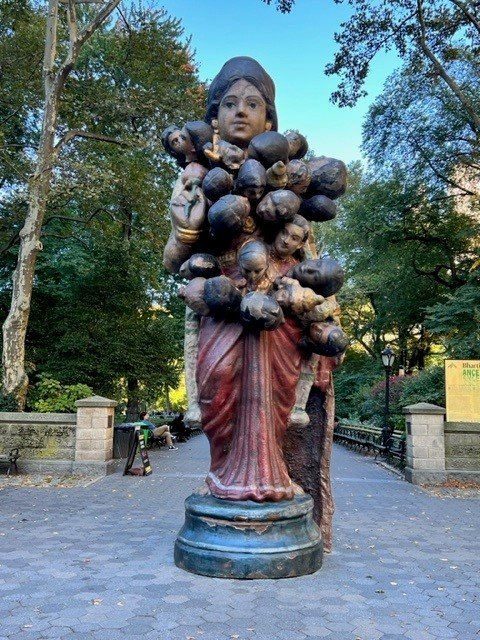
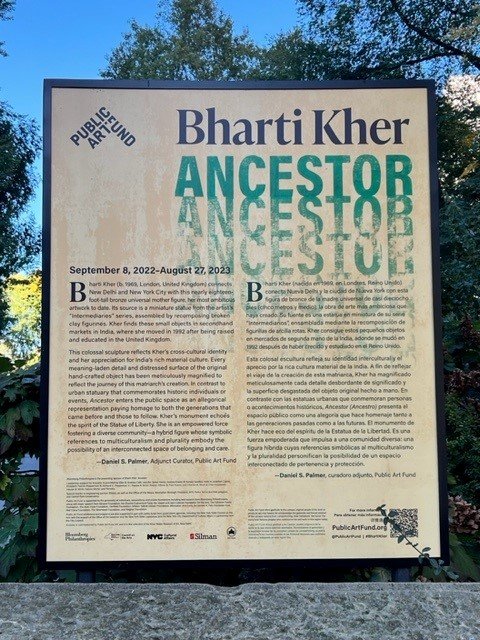
As we prepare to celebrate Diwali, The Festival of Lights, observed by Hindu, Buddhist, Sikh and Jain faiths we look upon New Delhi and London based artist Bharti Kher’s creation “Ancestor”. The 18 feet tall, bronze sculpture currently welcoming all visitors at New York City’s Central Park entrance at Doris C. Freedman Plaza, at 60th Street and 5th Avenue celebrates the light within us all.
Read more“Las flores de mi país” at the Central Park Arsenal
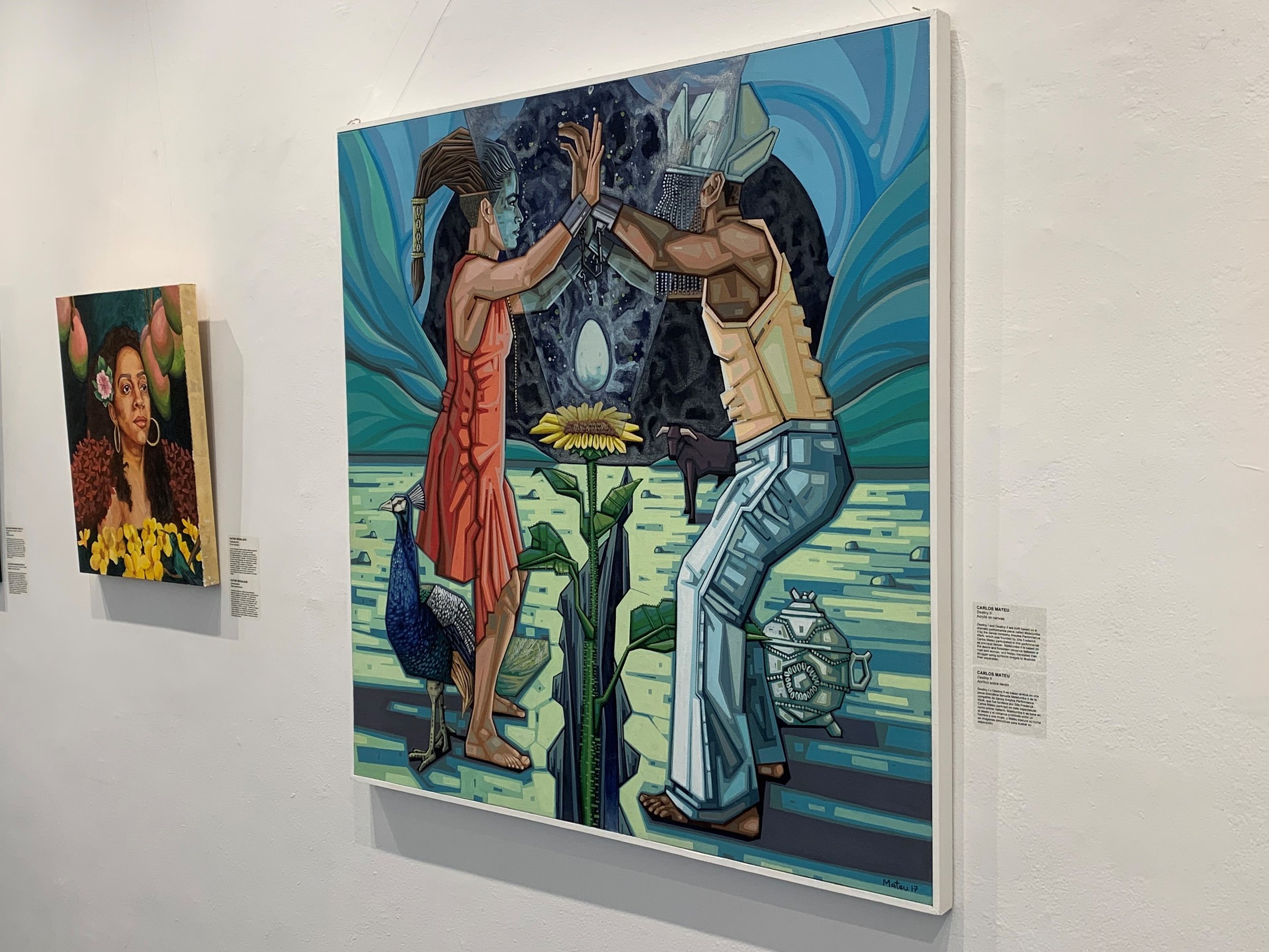

In celebration of Hispanic Heritage Month, the stately and imposing Central Park Arsenal, designed by the architect Martin Thompson plays host to “Las flores de mi país” (The Flowers of My Country), an art exhibit created in collaboration with the Department of Parks and Recreation’s Latino Society and its Art and Antiquities Division showcasing the works of Hispanic artists.
Nestled on the third floor of the Annex, in between offices and conference rooms of the headquarters of the New York City Department of Parks and Recreation, “Las flores de mi país” welcomes the public. “Las flores de mi país” is a wide-ranging and vibrant exhibition centering around plants, nature, and the power of home and heritage. Featuring photographs, paintings, sculpture, and mixed media creations, the theme of the show rotates around the beauty and culture of a homeland, and occasionally, the pain of leaving it behind. Works by more than twenty Latinx artists who hail from a variety of Caribbean, South, and Central American nations (including Puerto Rico, Colombia, Mexico, Honduras, Nicaragua, and El Salvador) dot the walls, with great splashes of color and large floral canvases dominating the space. Of particular note are a series of nine paintings by artist Daniel Delvalle, whose day job as a gardener for NYC Parks is immediately apparent in his perceptive and beautiful floral expressions.
“Las flores de mi país” is on view and free to the public through November 10, 2022, in the Arsenal Gallery.
Harlem Fire Watchtower
Harlem is one of New York City’s most vibrant and historically significant neighborhoods and home to the majestic Marcus Garvey Park . Perched 70 feet above street level, on top of the park’s Atrium, is the historical Harlem Fire Watchtower, also known as the Mount Morris Park Tower. Designed by James Bogardus and built by German American engineer Julius H. Kroehl, from 1855 to 1857, the Tower stands 47 feet tall, with a 10,000-pound bell suspended at its center.
After a catastrophic fire in 1835, a series of watch towers were built throughout New York City to give firefighters a bird’s eye view to watch over the wooden buildings of the community, and ring the bell to alert the local fire station. As industrialization swept America, and pull boxes were invented, the watchtowers, which numbered eleven at their peak, became obsolete, and in time the towers were torn down.
Due to its location in the city and the support of the community, the Harlem Fire Watchtower is the only surviving structure from Bogardus’ designs using cast-iron architecture which inspired the steel cages that help support our modern-day skyscrapers. The Tower became a New York City landmark in 1967, and underwent full restoration in 2019. Today, this historical monument stands tall, honoring the evolution of the NYC Fire Department.
“Windy” by Meriem Bennani
Along the High Line at 24th Street sits—or rather, spins—a new sculpture by New York-based artist Meriem Bennani. “Windy”, a spinning sculpture in the shape of a tornado and made of black foam, plays with traditions of public sculpture, as well as with what visuals and motions constitute the increasingly fast pace of life in New York City. The 9-foot-tall sculpture, on display until next May, is in non-stop motion powered by electrical bike motors, built to both withstand and interact with all four seasons of New York weather. The piece, which marks Benanni’s first public sculpture and her most abstract work to date, exists as an homage to the dynamism and constant movement of the city and the High Line specifically, capturing in art the urban energy of the place we call home. The frantic and perpetual motion of the sculpture “captures the experience of walking through New York City’s crowded streets and the frequency of movement on the High Line, one of the city’s most visited public parks. “Windy” is a poignant visual of New York City’s frenzied and intoxicating energy”.
Chasing Waterfalls at Greenacre Park

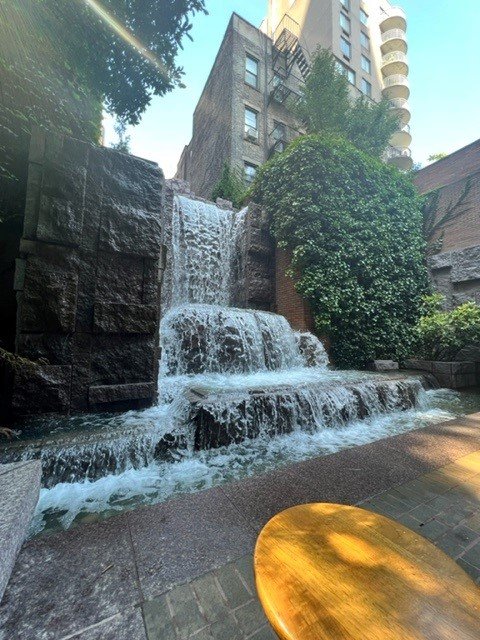
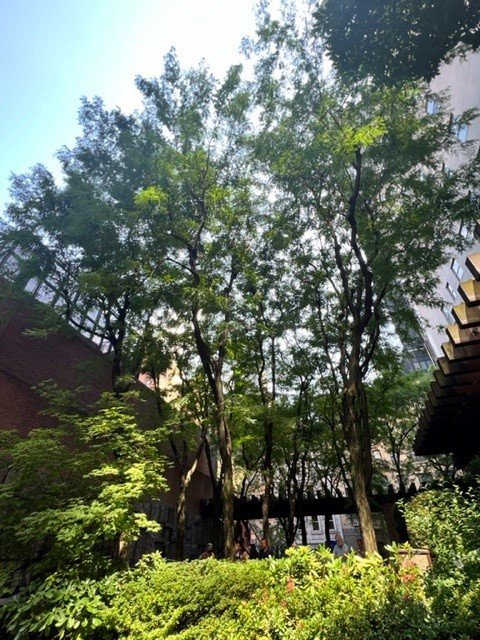
New York City is full of hidden treasures. Nestled on 51st Street between 2nd and 3rd Avenues is a gem known as Greenacre Park. Designed by Japanese American architect, Hideo Sasaki, and brought to life by the Greenacre Foundation, which was established by Abby Rockefeller Mauzé, the private park officially opened to the public in 1971. Mr. Sasaki’s vision for the space “to provide a place for the general public to gain special repose from the increasing city experience of noise, concrete, and humdrum,” comes to life in the park’s lush surroundings of shady honey locust trees, perennial flowers, and walls crawling with ivy. All of which create an enchanting oasis away from the bustling city streets. The highlight of this historical landmark is the twenty-five-foot-tall waterfall that cascades into the park from three stories up transforming the little park in Turtle Bay into a tropical sanctuary. The dramatic waterfall is loud enough to drown out of the sounds of the city, and also provides a welcoming tranquil brook just at foot of the waterfall. The park provides a fun, secret getaway in the heart of Mid-Town Manhattan where one can gather their thoughts and be transported to another place.
"You Know Who I Am" by Paola Pivi
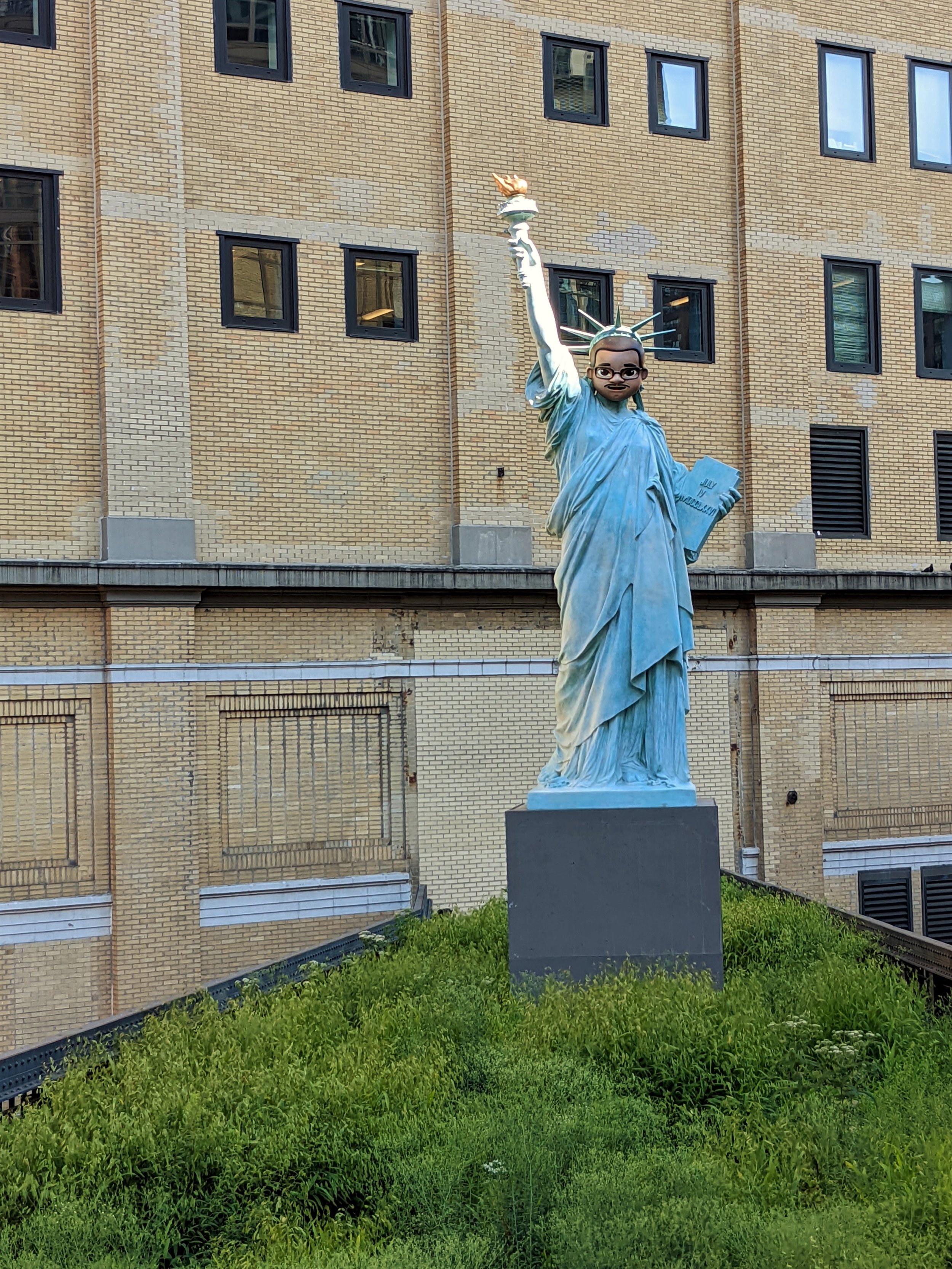
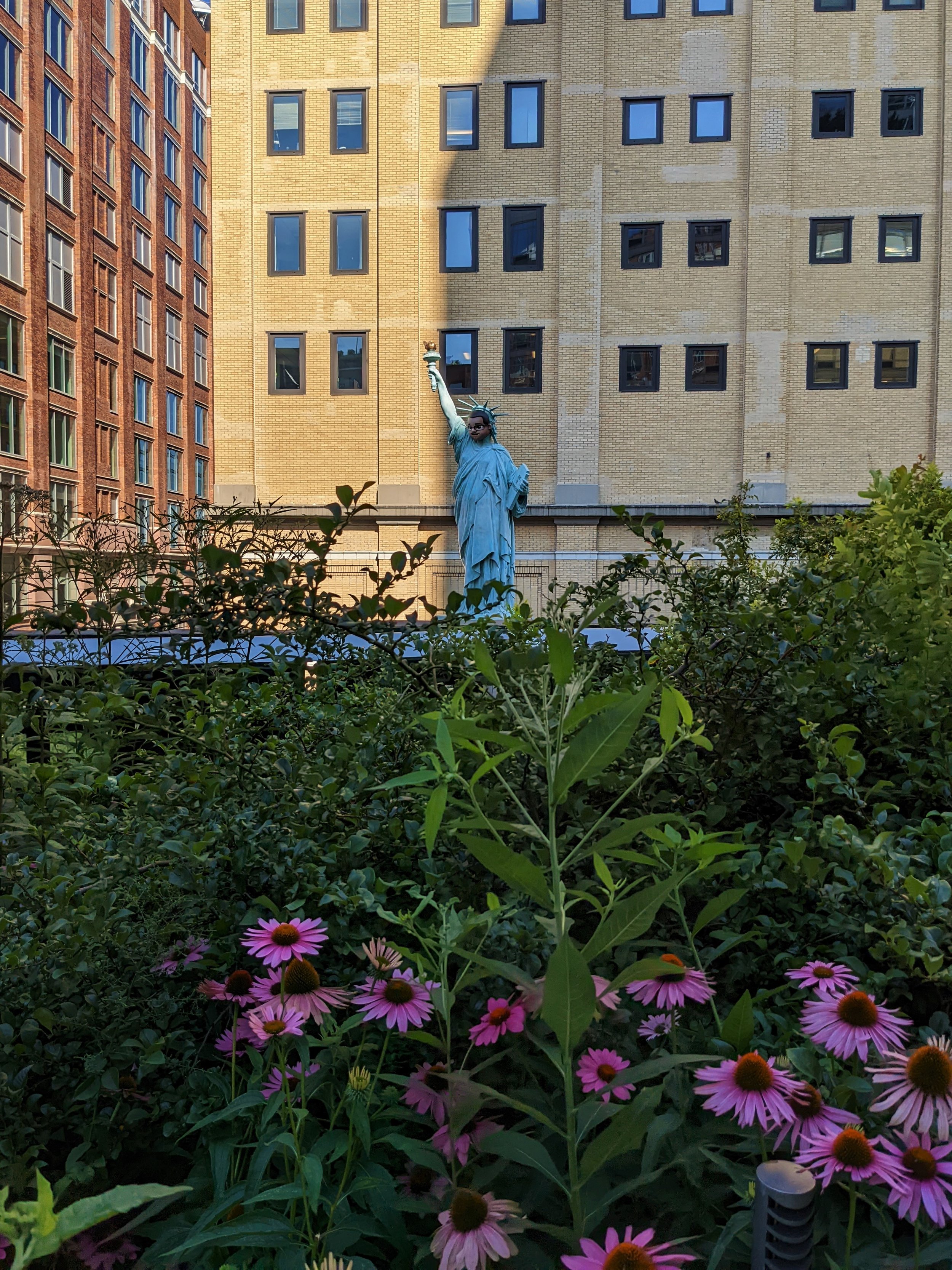
The Statue of Liberty stands in New York Harbor and has welcomed people to New York since 1886. For decades, immigrants processed through Ellis Island saw the enormous copper statue upon arriving at US shores. Though Ellis Island no longer processes arrivals to the US, the statue remains an iconic symbol of freedom and welcome. In a new work called “You Know Who I Am,” on view on the High Line in New York City, artist Paola Pivi has repurposed the image of the statue to reflect on those ideas of freedom and welcome in the US today. She created a smaller-scale replica of the Statue of Liberty and added a series of emoji-style masks, each representing “an individual whose experience of freedom is connected to the United States, offering the sentiment that anyone could be represented within the symbol of the statue.” Currently, the mask portrays Marco Saavedra, “an artist, poet, restauranteur, longtime immigrant rights activist, and community organizer based in the South Bronx.” After many years of activism and organizing, Saavedra set a legal precedent for undocumented activists when he was granted political asylum in 2021. The image of his face on the iconic statue puts the history of American immigration in conversation with the modern immigration landscape.
Listen to an interview with Mr. Saavedra here.
Renaissance Women by Alice Mizrachi
The Harlem Renaissance was the period from the 1910s through the mid-1930s when the New York City neighborhood of Harlem became the centerpiece of African-American culture, bursting with Black artists, poets, musicians, writers, dancers, and activists. “Renaissance Women,” by New York-based artist and educator Alice Mizrachi, is a sculpture of an abstracted feminine face. It looks like a line drawing inscribed in the air, as it is made of a single metal tube. Fittingly, the sculpture stands in Marcus Garvey Park in East Harlem, which is named for Harlem Renaissance activist Marcus Garvey. The sculpture honors the women of the Harlem Renaissance, like Zora Neale Hurston, Josephine Baker, Bessie Smith, Ethel Waters, Billie Holiday, Dorothy West, Augusta Savage, Lois Mailou Jones, and many more. Many of these women are still household names, and their lives and their work are still influential for scores of artists working today.
George Rickey on the Highline
One of the most influential American sculptors of the twentieth century, George Rickey spent much of his long career fascinated with the movements of the wind. He was captivated by “the waving of branches and the trembling of stems, the piling up or scudding of clouds, the rising and setting and waxing and waning of heavenly bodies.” His most famous sculptures reflect this preoccupation with movement. Rickey developed a distinct style of kinetic sculptures: simple, large-scale forms that were carefully balanced and calibrated to move with the slightest breeze. Several of these simple, gently moving pieces are currently on view at Kasmin Gallery’s rooftop sculpture garden in Chelsea, viewable from the High Line. The three works visible there, Five Lines in Parallel Planes, Peristyle II, and Two Red Lines, are all made up of elegant steel spikes, precisely balanced to sway and dip with the movements of the air. All created in the 1960s and 1970s, these pieces are emblematic of the sculptor’s signature style.





